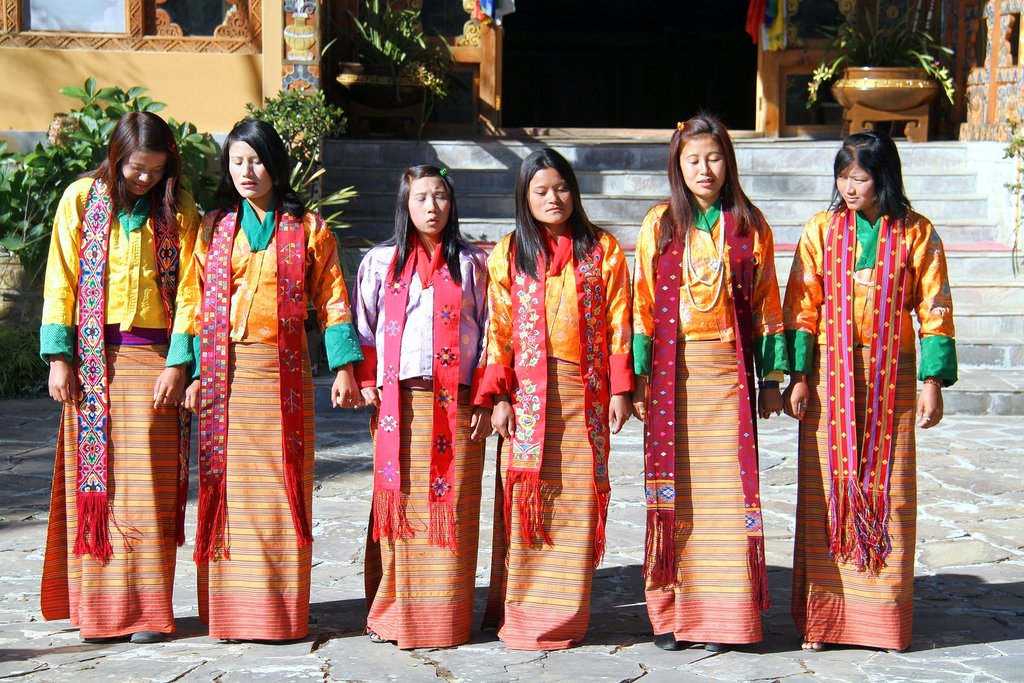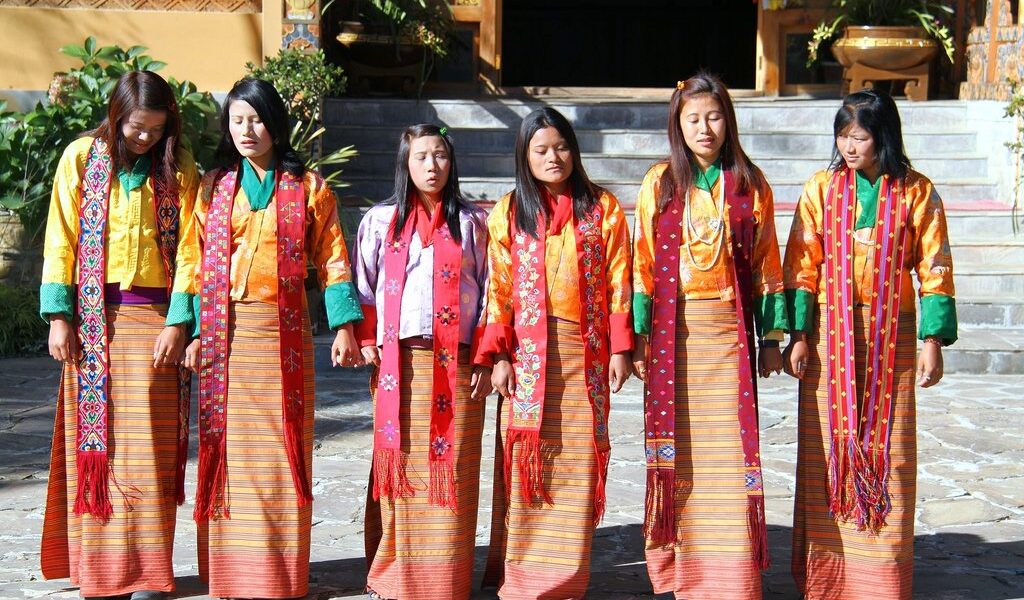
November is the tail end of the autumn peak season in Bhutan. While temperatures are dropping, particularly at night, this is still a good time to visit. Expect clear skies and beautiful views, as well as the chance to see migratory black-necked cranes. Here are a few things to know about traveling to Bhutan in November.
Weather in Bhutan During November
November in Bhutan signifies the arrival of late autumn. This period is often considered a particularly appealing time for travelers to visit this enchanting kingdom. The popularity stems from the combination of generally pleasant temperatures and notably clear skies that characterize the month. However, it’s important to acknowledge that as night descends, temperatures can dip, leading to noticeably colder conditions. This is especially true in areas at higher altitudes, and this phenomenon becomes more pronounced as the month progresses towards December.
The altitude plays a significant role in shaping the temperature variations experienced across Bhutan. While a substantial portion of the country sits at a considerable elevation, it’s crucial to remember that Bhutan is not uniformly high. The regions bordering India, particularly the jungles, possess a climate more akin to that of India. For instance, the charming town of Gelephu, which is situated near the captivating Royal Manas National Park, records an average high temperature of 81° F (27° C) in November. This means that it can still experience periods of considerable warmth. In contrast, Thimphu, the nation’s capital, is located at a substantial 7657 feet (2334 m) above sea level. Consequently, it experiences a climate that differs significantly from the lower-lying areas. Thimphu’s average high in November is a milder 64° F (18° C). Then there’s Punakha, a valley of subtropical beauty nestled at a lower altitude of 4074 feet (1242 m). Punakha enjoys an average high of 73° F (23° C) in November, making it a comfortable and inviting destination.
If your travel plans involve venturing into the mountainous regions for a trek, it is absolutely essential to be adequately equipped for colder temperatures, which are prevalent at higher elevations during November. However, for those who plan to spend their time in the lower towns, which are generally more frequented by tourists, a regular jacket should suffice to keep you warm and comfortable as you explore Bhutan’s stunning scenery and fascinating culture.
Crowds and Costs: What to Expect in November
November falls squarely within the peak tourist season in Bhutan. While it’s a busy time, it generally doesn’t reach the same levels of congestion as October, especially as the month moves closer to December. This means that many of the popular tourist attractions will be experiencing a higher volume of visitors. However, a unique aspect of Bhutanese tourism is that the country actively manages the number of tourists through a mandatory daily visa fee. This policy helps to ensure that crowds are never overwhelming. Even during the peak season, traveling in Bhutan offers a significantly less crowded experience compared to many other destinations in the region.
Nevertheless, it is critically important to make reservations for tours and book flights as early as possible if you have aspirations of attending any of Bhutan’s remarkable traditional festivals. The best accommodations tend to be booked well in advance due to high demand. Flight availability can also become limited around these festival periods. This is due to the fact that there are only a limited number of airports and routes that facilitate travel into Bhutan, so planning and booking early is absolutely essential to make the most of your trip.
Exploring Bhutan in November: Where to Go
In the context of visiting Bhutan in November, there truly isn’t any place that could be considered a ‘bad’ choice. The weather during this time is generally mild to cool across most regions, and the likelihood of rain is minimal to non-existent. This combination makes almost all areas of the country readily accessible and enjoyable for exploration. The clear skies and pleasant temperatures lend themselves to a truly memorable travel experience.
If your preference leans towards warmer weather and you harbor an interest in observing wildlife in their natural jungle habitat, you should consider heading to the Royal Manas National Park, which is situated in the southern part of Bhutan, bordering India. While November can still bring warm temperatures to this region, it’s notably less scorching than the heat experienced during the middle of the year. Embarking on jungle safaris in this particular area provides a completely different dimension to the Bhutanese experience, one that often surprises first-time visitors and offers a rich tapestry of flora and fauna.
As winter approaches, typically starting in late October and continuing into early November, a remarkable natural event occurs: black-necked cranes migrate from the elevated Tibetan Plateau to Bhutan. These magnificent birds find refuge in the serene Phobjikha Valley, where they settle in until the month of February. November is, therefore, an absolutely ideal time to visit the valley. It provides a fantastic opportunity to witness these graceful creatures in their winter habitat. Visitors can also explore the dedicated information center, which offers valuable insights into the life and conservation of these birds. Additionally, there is a festival specifically dedicated to celebrating the cranes (more details are provided further below).
November also presents a window of opportunity to explore some of the more remote and challenging-to-reach destinations within Bhutan. These places are often difficult or even impossible to access during the winter months or the monsoon season. Bumthang, nestled in Central Bhutan, holds the esteemed title of being the cultural and religious heartland of Bhutan. It is home to some of the nation’s oldest and most revered temples and monasteries. Furthermore, Bumthang is characterized by a series of incredibly fertile valleys. After the monsoon rains, these valleys come alive with vibrant green fields that stretch across the landscape, creating a breathtaking visual spectacle.
What to Do During Your November Visit
If you are prepared to deal with colder temperatures, especially when at higher altitudes, then November is considered to be an outstanding month for trekking in Bhutan. During this month, the skies are generally clear, providing for stunning views of the magnificent mountains that dominate the landscape. While the longer and more challenging treks, such as the famed Snowman Trek, are typically best undertaken in October when temperatures at the higher elevations are somewhat less severe, there are numerous shorter treks that are both worthwhile and ideally suited for exploration in the month of November.
One particularly special event that is undoubtedly worth traveling to Bhutan for during November is the annual Black-Necked Crane Festival. Further details about this unique cultural celebration are provided below.
Key Events Taking Place in November
The Black-Necked Crane Festival, held annually on November 11th at Gangtey Gompa in the Phobjikha Valley, stands as a vibrant celebration of the return of these majestic birds to their winter home. During the festival, children often don costumes that mimic the appearance of cranes and perform traditional dances within the temple courtyard. In contrast to many other Bhutanese religious festivals, which follow a lunar calendar and therefore have shifting dates, the Black-Necked Crane Festival is unique in that its date remains fixed year after year.
The Trashigang Tsechu, held in Eastern Bhutan, offers a compelling reason to venture into the remote and less-visited eastern regions of the country. This festival spans three days and typically attracts very few foreign visitors, providing a truly authentic cultural experience.
Suggested Itineraries for Traveling to Bhutan in November
Here are some suggested itineraries for travelling to Bhutan in November:
Bhutan Birding Trip – 9 Days. Consider combining this delightful bird-watching adventure with a visit to Phobjikha’s Black-Necked Crane Festival, held annually on November 11th. This combination creates the ultimate experience for bird enthusiasts and nature lovers.
Nature and Culture in Western and Central Bhutan – 12 Days. The remote regions of Central Bhutan offer a treasure trove of cultural and natural attractions that are rarely seen by outsiders. November is an excellent time to explore these hidden gems.
Bike Tour of Bhutan – 15 Days. Immerse yourself in the fascinating culture and stunning landscapes of Bhutan on this unforgettable two-week cycling adventure. It’s an active and engaging way to discover the beauty of this unique kingdom.
Explore Bhutan: Dagala Trek and Cultural Highlights – 10 Days. In addition to the five-day trek to the picturesque lakes, this itinerary includes visits to some of Bhutan’s most iconic highlights, including Thimphu, Paro, and the scenic Punakha Valley, providing a well-rounded and diverse travel experience.
Additional Resources for Planning Your Trip
For further reading and planning, consider exploring the following resources to help you make the most of your trip to Bhutan.
B-167

